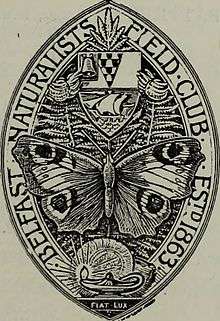Belfast Naturalists' Field Club
The Belfast Naturalists' Field Club is a club of naturalists based in Belfast, Northern Ireland. Founded in 1863, the club was an important part of the education system for Victorian naturalists and worked largely through first-hand field studies.[1] It has been credited with playing an important role in the elucidation of glacial and post-glacial sea levels, climates and fossil beaches and issuing the first of the regional handbooks for meetings of the British Association for the Advancement of Science as far back as 1874.[2] The club has four sections, Archeology & History, Botany, Geology and Zoology, and has published several books and a periodical. The Herbarium of the BNFC is now in the Ulster Museum.[3]

History
The club was formed as the first of a series of Field Clubs (followed by clubs in Dublin (1886), Cork (1892), and Limerick (1892)) established in response to the increasing interest in natural sciences in the Victorian Society of Ireland.[1] The first public meeting was held on the March 6, 1863. Ralph Tate drafted a document which provided a draft Constitution. The first meeting was held in the Museum Buildings, now the Ulster Museum.[4] The first field trip organized by the Club occurred on 6 April 1863. 88 members travelled to Islandmagee to collect fossils. Since then members of the Club have visited many areas including the Cavehill, the Giant's Causeway, Mount Stewart and Strangford Lough to name but a few.[5]
Books
- Systematic Lists Illustrative of the Flora, Fauna, Palaeontology and Archeology of the North of Ireland, 1870
- Guide to Belfast and the adjacent counties, 1874
- Catalogue of a Collection of Irish Antiquities, 1874
- A Guide to Belfast and the Counties of Down & Antrim, 1902
- A Preliminary Report on the Survey of the County Armagh Flora, 1965-1967, 1968
- Urban Flora of Belfast: A project of the Belfast Naturalists' Field Club. 1997, by Stan Beesley, John Wilde.[6]
Periodicals
References
- P.W. Jackson (1992) The Irish Naturalist: 33 years of natural history in Ireland 1892-1924. Irish Naturalists' Journal 24(3): 95-101
- E.E. Evans (1970) The Personality of Ulster. Transactions of the Institute of British Geographers, No. 51, pp. 1-20.
- Hackney, P. (Ed.) (1992). Stewart & Corry's Flora of the North-east of Ireland. Third edition. Institute of Irish Studies, The Queen's University of Belfast. ISBN 0-85389-446-9
- Campbell, A. Albert (1938). Belfast Naturalists' Field Club : its origin and progress. Belfast: Hugh Greer. doi:10.5962/bhl.title.70133. Retrieved 20 January 2016.
- "Deane,C.Douglas" 1983. "The Ulster Countryside." Century Books. ISBN 0-903152-17-7
- Wilde, John A.; Beesley, Stan (1997). Urban flora of Belfast. Belfast, Northern Ireland: Institute of Irish Studies, Queen's University of Belfast. ISBN 0-85389-695-X.
- Serial Publications in the British Museum (Natural History) Library. British Museum, 1980 - Library Search
Further references
- Scott, R. 2004. Wild Belfast on Safari in the City. The Blackstaff Press, Belfast. ISBN 0-85640-762-3.
- Crowther, Peter. 2013. Citizen Science 150 years of the Belfast Naturalists' Field Club. National Museums Northern Ireland. ISBN 090076158X